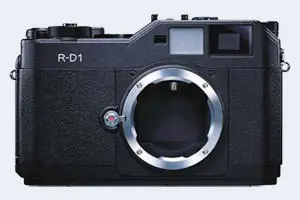Epson R-D1 vs Panasonic FZ2000
The Epson R-D1 and the Panasonic Lumix DMC-FZ2000 (labelled Panasonic FZ2500 in some countries) are two digital cameras that were officially introduced, respectively, in March 2004 and September 2016. The R-D1 is a rangefinder-focusing mirrorless camera, while the FZ2000 is a fixed lens compact. The cameras are based on an APS-C (R-D1) and an one-inch (FZ2000) sensor. The Epson has a resolution of 6 megapixels, whereas the Panasonic provides 20 MP.
Below is an overview of the main specs of the two cameras as a starting point for the comparison.

Check R-D1 offers at
ebay.com

Check FZ2000 price at
amazon.com
Going beyond this snapshot of core features and characteristics, what are the differences between the Epson R-D1 and the Panasonic Lumix DMC-FZ2000? Which one should you buy? Read on to find out how these two cameras compare with respect to their body size, their imaging sensors, their shooting features, their input-output connections, and their reception by expert reviewers.
Body comparison
The side-by-side display below illustrates the physical size and weight of the Epson R-D1 and the Panasonic FZ2000. The two cameras are presented according to their relative size. Three consecutive perspectives from the front, the top, and the back are available. All width, height and depth dimensions are rounded to the nearest millimeter.
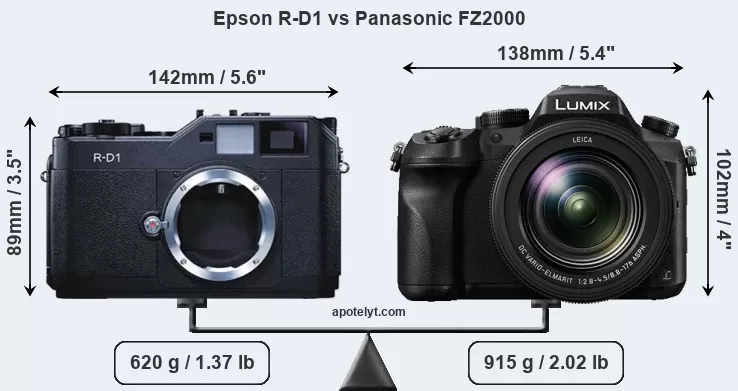
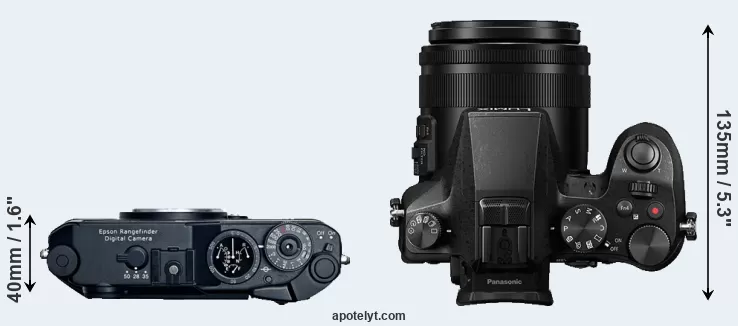
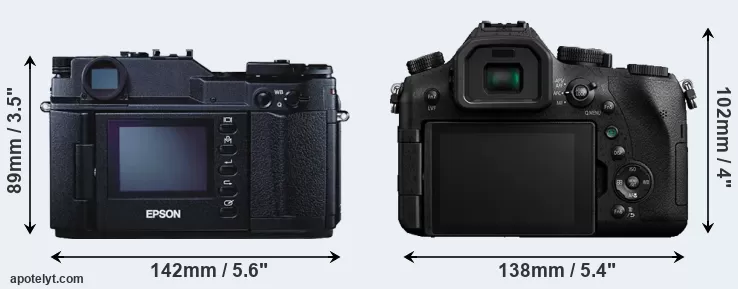
If the front view area (width x height) of the cameras is taken as an aggregate measure of their size, the Panasonic FZ2000 is notably larger (11 percent) than the Epson R-D1. In this context, it is worth noting that neither the R-D1 nor the FZ2000 are weather-sealed.
The above size and weight comparisons are to some extent incomplete and possibly misleading, as the FZ2000 has a lens built in, whereas the R-D1 is an interchangeable lens camera that requires a separate lens. Attaching the latter will add extra weight and bulk to the setup. You can compare the optics available for the R-D1 and their specifications in the Leica M Lens Catalog.
The adjacent table lists the principal physical characteristics of the two cameras alongside a wider set of alternatives. If you want to switch the focus of the display and review another camera pair, you can move across to the CAM-parator tool and choose from the broad selection of possible camera comparisons there.

| Camera Model |
Camera Width |
Camera Height |
Camera Depth |
Camera Weight |
Battery Life |
Weather Sealing |
Camera Launch |
Launch Price (USD) |
Street Price |
||
|---|---|---|---|---|---|---|---|---|---|---|---|
| 1. | Epson R-D1 | 142 mm | 89 mm | 40 mm | 620 g | .. | n | Mar 2004 | 2,999 | ebay.com | |
| 2. | Panasonic FZ2000 | 138 mm | 102 mm | 135 mm | 915 g | 350 | n | Sep 2016 | 1,199 | amazon.com | |
| 3. | Canon Rebel | 142 mm | 99 mm | 72 mm | 649 g | 400 | n | Aug 2003 | 899 | ebay.com | |
| 4. | Fujifilm X100F | 127 mm | 75 mm | 52 mm | 469 g | 390 | n | Jan 2017 | 1,299 | ebay.com | |
| 5. | Leica CL | 131 mm | 78 mm | 45 mm | 403 g | 220 | n | Nov 2017 | 2,795 | ebay.com | |
| 6. | Leica M9 | 139 mm | 80 mm | 37 mm | 585 g | 550 | n | Sep 2009 | 7,999 | ebay.com | |
| 7. | Leica M10 | 139 mm | 80 mm | 39 mm | 660 g | 210 | Y | Jan 2017 | 6,595 | ebay.com | |
| 8. | Leica X Vario | 133 mm | 73 mm | 95 mm | 680 g | 450 | n | Jun 2013 | 2,850 | ebay.com | |
| 9. | Leica X-U Typ 113 | 140 mm | 79 mm | 88 mm | 635 g | 450 | Y | Jan 2016 | 2,950 | ebay.com | |
| 10. | Nikon D40 | 124 mm | 94 mm | 64 mm | 522 g | 470 | n | Nov 2006 | 499 | ebay.com | |
| 11. | Nikon D50 | 133 mm | 102 mm | 76 mm | 620 g | 400 | n | Apr 2005 | 749 | ebay.com | |
| 12. | Nikon D70 | 140 mm | 111 mm | 78 mm | 679 g | 400 | n | Jan 2004 | 999 | ebay.com | |
| 13. | Nikon D70s | 140 mm | 111 mm | 78 mm | 679 g | 500 | n | Apr 2005 | 899 | ebay.com | |
| 14. | Panasonic FZ1000 | 137 mm | 99 mm | 131 mm | 831 g | 360 | n | Jun 2014 | 899 | ebay.com | |
| 15. | Sony RX10 II | 129 mm | 88 mm | 102 mm | 813 g | 400 | Y | Jun 2015 | 1,299 | ebay.com | |
| 16. | Sony RX100 IV | 102 mm | 58 mm | 41 mm | 298 g | 280 | n | Jun 2015 | 999 | ebay.com | |
| 17. | Sony RX100 V | 102 mm | 58 mm | 41 mm | 299 g | 220 | n | Oct 2016 | 999 | ebay.com | |
| Note: Measurements and pricing do not include easily detachable parts, such as add-on or interchangeable lenses or optional viewfinders. | |||||||||||
The price is, of course, an important factor in any camera decision. The listed launch prices provide an indication of the market segment that the manufacturer of the cameras have been targeting. The FZ2000 was launched at a lower price than the R-D1, despite having a lens built in. Usually, retail prices stay at first close to the launch price, but after several months, discounts become available. Later in the product cycle and, in particular, when the replacement model is about to appear, further discounting and stock clearance sales often push the camera price considerably down. Then, after the new model is out, very good deals can frequently be found on the pre-owned market.
Sensor comparison
The imaging sensor is at the core of digital cameras and its size is one of the main determining factors of image quality. A large sensor will generally have larger individual pixels that offer better low-light sensitivity, provide wider dynamic range, and have richer color-depth than smaller pixels in a sensor of the same technological generation. Moreover, a large sensor camera will give the photographer more control over depth-of-field in the image and, thus, the ability to better isolate a subject from the background. On the downside, larger sensors are more costly to manufacture and tend to lead to bigger and heavier cameras and lenses.
Of the two cameras under consideration, the Epson R-D1 features an APS-C sensor and the Panasonic FZ2000 an one-inch sensor. The sensor area in the FZ2000 is 69 percent smaller. As a result of these sensor size differences, the cameras have a format factor of, respectively, 1.5 and 2.7. Both cameras have a native aspect ratio (sensor width to sensor height) of 3:2.
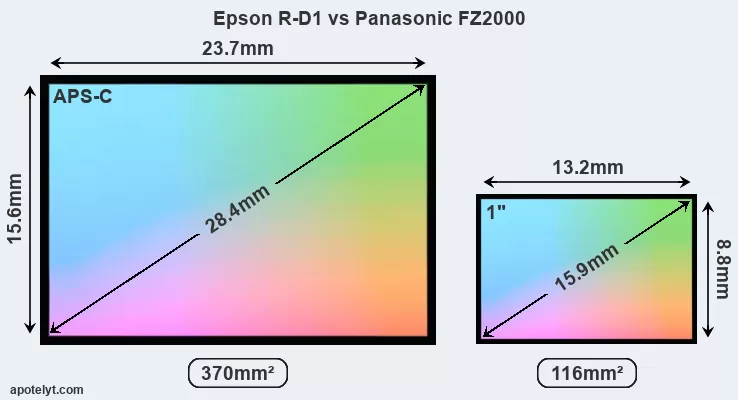
Despite having a smaller sensor, the FZ2000 offers a higher resolution of 20 megapixels, compared with 6 MP of the R-D1. This megapixels advantage comes at the cost of a higher pixel density and a smaller size of the individual pixel (with a pixel pitch of 2.41μm versus 7.85μm for the R-D1). However, it should be noted that the FZ2000 is much more recent (by 12 years and 6 months) than the R-D1, and its sensor will have benefitted from technological advances during this time that make it possible to gather light more efficiently.
The resolution advantage of the Panasonic FZ2000 implies greater flexibility for cropping images or the possibility to print larger pictures. The maximum print size of the FZ2000 for good quality output (200 dots per inch) amounts to 27.4 x 18.2 inches or 69.5 x 46.3 cm, for very good quality (250 dpi) 21.9 x 14.6 inches or 55.6 x 37.1 cm, and for excellent quality (300 dpi) 18.2 x 12.2 inches or 46.3 x 30.9 cm. The corresponding values for the Epson R-D1 are 15 x 10 inches or 38.2 x 25.4 cm for good quality, 12 x 8 inches or 30.6 x 20.3 cm for very good quality, and 10 x 6.7 inches or 25.5 x 16.9 cm for excellent quality prints.
The Epson R-D1 has a native sensitivity range from ISO 200 to ISO 1600. The corresponding ISO settings for the Panasonic Lumix DMC-FZ2000 are ISO 125 to ISO 12800, with the possibility to increase the ISO range to 80-25600.
In terms of underlying technology, the R-D1 is build around a CCD sensor, while the FZ2000 uses a BSI-CMOS imager. Both cameras use a Bayer filter for capturing RGB colors on a square grid of photosensors. This arrangement is found in most digital cameras.
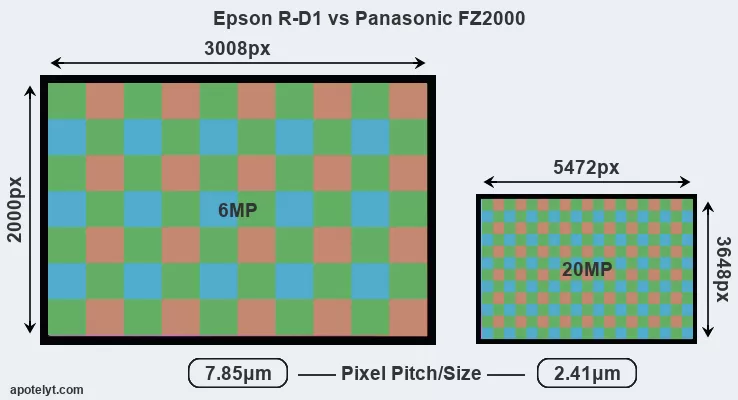
Since 2007, DXO Mark has published sensor performance measurements that have been derived using a consistent methodology. This service determines an overall sensor rating, as well as sub-scores for low-light sensitivity ("DXO Sports"), dynamic range ("DXO Landscape"), and color depth ("DXO Portrait"). The following table provides an overview of the physical sensor characteristics, as well as the sensor quality measurements for a selection of comparators.

| Camera Model |
Sensor Class |
Resolution (MP) |
Horiz. Pixels |
Vert. Pixels |
Video Format |
DXO Portrait |
DXO Landscape |
DXO Sports |
DXO Overall |
||
|---|---|---|---|---|---|---|---|---|---|---|---|
| 1. | Epson R-D1 | APS-C | 6.0 | 3008 | 2000 | none | 21.1 | 10.4 | 564 | 55 | |
| 2. | Panasonic FZ2000 | 1-inch | 20.0 | 5472 | 3648 | 4K/30p | 23.0 | 12.6 | 538 | 70 | |
| 3. | Canon Rebel | APS-C | 6.3 | 3072 | 2048 | none | 21.0 | 10.8 | 544 | 55 | |
| 4. | Fujifilm X100F | APS-C | 24.0 | 6000 | 4000 | 1080/60p | 23.9 | 13.2 | 1704 | 81 | |
| 5. | Leica CL | APS-C | 24.1 | 6014 | 4014 | 4K/30p | 24.0 | 13.3 | 1788 | 82 | |
| 6. | Leica M9 | Full Frame | 18.1 | 5212 | 3472 | none | 22.5 | 11.7 | 884 | 69 | |
| 7. | Leica M10 | Full Frame | 23.8 | 5952 | 3992 | none | 24.4 | 13.2 | 2133 | 86 | |
| 8. | Leica X Vario | APS-C | 16.1 | 4928 | 3272 | 1080/30p | 23.4 | 12.7 | 1320 | 78 | |
| 9. | Leica X-U Typ 113 | APS-C | 16.1 | 4928 | 3264 | 1080/30p | 23.8 | 13.0 | 1614 | 80 | |
| 10. | Nikon D40 | APS-C | 6.0 | 3008 | 2000 | none | 21.0 | 11.0 | 561 | 56 | |
| 11. | Nikon D50 | APS-C | 6.0 | 3008 | 2000 | none | 20.9 | 10.8 | 560 | 55 | |
| 12. | Nikon D70 | APS-C | 6.0 | 3008 | 2000 | none | 20.4 | 10.3 | 529 | 50 | |
| 13. | Nikon D70s | APS-C | 6.0 | 3008 | 2000 | none | 20.4 | 10.3 | 529 | 50 | |
| 14. | Panasonic FZ1000 | 1-inch | 20.0 | 5472 | 3648 | 4K/30p | 22.1 | 11.7 | 517 | 64 | |
| 15. | Sony RX10 II | 1-inch | 20.0 | 5472 | 3648 | 4K/30p | 23.0 | 12.6 | 531 | 70 | |
| 16. | Sony RX100 IV | 1-inch | 20.0 | 5472 | 3648 | 4K/30p | 22.8 | 12.6 | 591 | 70 | |
| 17. | Sony RX100 V | 1-inch | 20.0 | 5472 | 3648 | 4K/30p | 22.8 | 12.4 | 586 | 70 | |
| Note: DXO values in italics represent estimates based on sensor size and age. | |||||||||||
Many modern cameras are not only capable of taking still images, but also of capturing video footage. The FZ2000 indeed provides for movie recording, while the R-D1 does not. The highest resolution format that the FZ2000 can use is 4K/30p.
Feature comparison
Apart from body and sensor, cameras can and do differ across a variety of features. For example, the FZ2000 has an electronic viewfinder (2360k dots), while the R-D1 has an optical one. Both systems have their advantages, with the electronic viewfinder making it possible to project supplementary shooting information into the framing view, whereas the optical viewfinder offers lag-free viewing and a very clear framing image. The adjacent table lists some of the other core features of the Epson R-D1 and Panasonic FZ2000 along with similar information for a selection of comparators.

| Camera Model |
Viewfinder (Type or 000 dots) |
Control Panel (yes/no) |
LCD Specifications (inch/000 dots) |
LCD Attach- ment |
Touch Screen (yes/no) |
Max Shutter Speed * |
Max Shutter Flaps * |
Built-in Flash (yes/no) |
Built-in Image Stab |
||
|---|---|---|---|---|---|---|---|---|---|---|---|
| 1. | Epson R-D1 | optical | n | 2.0 / 235 | fixed | n | 1/2000s | 1.0/s | n | n | |
| 2. | Panasonic FZ2000 | 2360 | n | 3.0 / 1040 | swivel | Y | 1/4000s | 12.0/s | Y | Y | |
| 3. | Canon Rebel | optical | n | 1.8 / 118 | fixed | n | 1/4000s | 2.5/s | Y | n | |
| 4. | Fujifilm X100F | 2360 | n | 3.0 / 1040 | fixed | n | 1/4000s | 8.0/s | Y | n | |
| 5. | Leica CL | 2360 | Y | 3.0 / 1040 | fixed | Y | 1/8000s | 10.0/s | n | n | |
| 6. | Leica M9 | optical | n | 2.5 / 230 | fixed | n | 1/4000s | 2.0/s | n | n | |
| 7. | Leica M10 | optical | n | 3.0 / 1037 | fixed | n | 1/4000s | 5.0/s | n | n | |
| 8. | Leica X Vario | optional | n | 3.0 / 920 | fixed | n | 1/2000s | 5.0/s | Y | n | |
| 9. | Leica X-U Typ 113 | optional | n | 3.0 / 920 | fixed | n | 1/2000s | 5.0/s | Y | n | |
| 10. | Nikon D40 | optical | n | 2.5 / 230 | fixed | n | 1/4000s | 2.5/s | Y | n | |
| 11. | Nikon D50 | optical | n | 2.0 / 130 | fixed | n | 1/4000s | 2.5/s | Y | n | |
| 12. | Nikon D70 | optical | n | 1.8 / 130 | fixed | n | 1/8000s | 3.0/s | Y | n | |
| 13. | Nikon D70s | optical | n | 2.0 / 130 | fixed | n | 1/8000s | 3.0/s | Y | n | |
| 14. | Panasonic FZ1000 | 2359 | n | 3.0 / 921 | swivel | n | 1/4000s | 12.0/s | Y | Y | |
| 15. | Sony RX10 II | 2359 | Y | 3.0 / 1229 | tilting | n | 1/3200s | 14.0/s | Y | Y | |
| 16. | Sony RX100 IV | 2359 | n | 3.0 / 1228 | tilting | n | 1/2000s | 16.0/s | Y | Y | |
| 17. | Sony RX100 V | 2359 | n | 3.0 / 1229 | tilting | n | 1/2000s | 24.0/s | Y | Y | |
| Note: *) Information refers to the mechanical shutter, unless the camera only has an electronic one. | |||||||||||
One differentiating feature between the two cameras concerns the touch sensitivity of the rear screen. The FZ2000 has a touchscreen, while the R-D1 has a conventional panel. Touch control can be particularly helpful, for example, for setting the focus point.
The FZ2000 has an articulated screen that can be turned to be front-facing. This characteristic will be appreciated by vloggers and photographers who are interested in taking selfies. In contrast, the R-D1 does not have a selfie-screen.The reported shutter speed information refers to the use of the mechanical shutter. Yet, some cameras only have an electronic shutter, while others have an electronic shutter in addition to a mechanical one. In fact, the FZ2000 is one of those camera that have an additional electronic shutter, which makes completely silent shooting possible. However, this mode is less suitable for photographing moving objects (risk of rolling shutter) or shooting under artificial light sources (risk of flickering).
The Panasonic FZ2000 has an intervalometer built-in. This enables the photographer to capture time lapse sequences, such as flower blooming, a sunset or moon rise, without purchasing an external camera trigger and related software.
The R-D1 writes its imaging data to SDHC cards, while the FZ2000 uses SDXC cards. The FZ2000 supports UHS-I cards (Ultra High Speed data transfer of up to 104 MB/s), while the R-D1 cannot take advantage of Ultra High Speed SD cards.
Connectivity comparison
For some imaging applications, the extent to which a camera can communicate with its environment can be an important aspect in the camera decision process. The table below provides an overview of the connectivity of the Epson R-D1 and Panasonic Lumix DMC-FZ2000 and, in particular, the interfaces the cameras (and selected comparators) provide for accessory control and data transfer.

| Camera Model |
Hotshoe Port |
Internal Mic / Speaker |
Microphone Port |
Headphone Port |
HDMI Port |
USB Port |
WiFi Support |
NFC Support |
Bluetooth Support |
||
|---|---|---|---|---|---|---|---|---|---|---|---|
| 1. | Epson R-D1 | Y | - / - | - | - | - | - | - | - | - | |
| 2. | Panasonic FZ2000 | Y | stereo / mono | Y | Y | micro | 2.0 | Y | - | - | |
| 3. | Canon Rebel | Y | - / - | - | - | - | 1.1 | - | - | - | |
| 4. | Fujifilm X100F | Y | stereo / mono | Y | - | micro | 2.0 | Y | - | - | |
| 5. | Leica CL | Y | stereo / mono | - | - | - | - | Y | - | - | |
| 6. | Leica M9 | Y | - / - | - | - | - | 2.0 | - | - | - | |
| 7. | Leica M10 | Y | - / - | - | - | - | - | Y | - | - | |
| 8. | Leica X Vario | Y | stereo / mono | - | - | mini | 2.0 | - | - | - | |
| 9. | Leica X-U Typ 113 | Y | stereo / mono | - | - | - | 2.0 | - | - | - | |
| 10. | Nikon D40 | Y | - / - | - | - | - | 2.0 | - | - | - | |
| 11. | Nikon D50 | Y | - / - | - | - | - | 2.0 | - | - | - | |
| 12. | Nikon D70 | Y | - / - | - | - | - | 1.0 | - | - | - | |
| 13. | Nikon D70s | Y | - / - | - | - | - | 2.0 | - | - | - | |
| 14. | Panasonic FZ1000 | Y | stereo / mono | Y | - | micro | 2.0 | Y | Y | - | |
| 15. | Sony RX10 II | Y | stereo / mono | Y | Y | micro | 2.0 | Y | Y | - | |
| 16. | Sony RX100 IV | - | stereo / mono | - | - | micro | 2.0 | Y | Y | - | |
| 17. | Sony RX100 V | - | stereo / mono | - | - | micro | 2.0 | Y | Y | - |
It is notable that the FZ2000 offers wifi support, which can be a very convenient means to transfer image data to an off-camera location. In contrast, the R-D1 does not provide wifi capability.
Studio photographers will appreciate that the Epson R-D1 (unlike the FZ2000) features a PC Sync socket, so that professional strobe lights can be controlled by the camera.
The FZ2000 is a recent model that features in the current product line-up of Panasonic. In contrast, the R-D1 has been discontinued (but can be found pre-owned on ebay). There has not been a direct replacement model for the R-D1 from Epson. Further information on the features and operation of the R-D1 and FZ2000 can be found, respectively, in the Epson R-D1 Manual (free pdf) or the online Panasonic FZ2000 Manual.
Review summary
So what conclusions can be drawn? Is the Epson R-D1 better than the Panasonic FZ2000 or vice versa? A synthesis of the relative strong points of each of the models is listed below.

Arguments in favor of the Epson R-D1:
- Brighter framing: Features an optical viewfinder for clear, lag-free composition.
- More flexible: Accepts interchangeable lenses, so that lens characteristics can be altered.
- Better studio light control: Has a PC Sync socket to connect to professional strobe lights.
- More heavily discounted: Has been available for much longer (launched in March 2004).

Advantages of the Panasonic Lumix DMC-FZ2000:
- More detail: Has more megapixels (20 vs 6MP), which boosts linear resolution by 82%.
- Broader imaging potential: Can capture not only stills but also 4K/30p video.
- More framing info: Has an electronic viewfinder that displays shooting data.
- Larger screen: Has a bigger rear LCD (3.0" vs 2.0") for image review and settings control.
- More detailed LCD: Has a higher resolution rear screen (1040k vs 235k dots).
- More flexible LCD: Has a swivel screen for odd-angle shots in portrait or landscape orientation.
- Fewer buttons to press: Has a touchscreen to facilitate handling and shooting adjustments.
- More selfie-friendly: Has an articulated screen that can be turned to be front-facing.
- Faster shutter: Has higher mechanical shutter speed (1/4000s vs 1/2000s) to freeze action.
- Faster burst: Shoots at higher frequency (12 vs 1 flaps/sec) to capture the decisive moment.
- Less disturbing: Has an electronic shutter option for completely silent shooting.
- Easier time-lapse photography: Has an intervalometer built-in for low frequency shooting.
- Ready to shoot: Has an integrated lens, whereas the R-D1 necessitates an extra lens.
- Sharper images: Has stabilization technology built-in to reduce the impact of hand-shake.
- Easier fill-in: Has a small integrated flash to brighten shadows of backlit subjects.
- Easier file upload: Has wifi built in for automatic backup or image transfer to the web.
- Faster buffer clearing: Has an SD card interface that supports the UHS-I standard.
- More affordable: Was introduced at a lower price, despite coming with a built-in lens.
- More modern: Reflects 12 years and 6 months of technical progress since the R-D1 launch.
If the count of relative strengths (bullet points above) is taken as a measure, the FZ2000 is the clear winner of the contest (19 : 4 points). However, the relevance of individual strengths will vary across photographers, so that you might want to apply your own weighing scheme to the summary points when reflecting and deciding on a new camera. A professional sports photographer will view the differences between cameras in a way that diverges from the perspective of a street photog, and a person interested in family portraits has distinct needs from a landscape shooter. Hence, the decision which camera is best and worth buying is often a very personal one.
In any case, while the specs-based evaluation of cameras can be instructive in revealing their potential as photographic tools, it says little about, for example, the shooting experience and imaging performance of the R-D1 and the FZ2000 in practical situations. User reviews, such as those found at amazon, can sometimes inform about these issues, but such feedback is often incomplete, inconsistent, and biased.
Expert reviews
This is why expert reviews are important. The following table reports the overall ratings of the cameras as published by some of the major camera review sites (amateurphotographer [AP], cameralabs [CL], digitalcameraworld [DCW], dpreview [DPR], ephotozine [EPZ], photographyblog [PB]). As can be seen, the professional reviewers agree in many cases on the quality of different cameras, but sometimes their assessments diverge, reinforcing the earlier point that a camera decision is often a very personal choice.

| Camera Model |
AP score |
CL score |
DCW score |
DPR score |
EPZ score |
PB score |
Camera Launch |
Launch Price (USD) |
Street Price |
||
|---|---|---|---|---|---|---|---|---|---|---|---|
| 1. | Epson R-D1 | .. | .. | .. | .. | .. | .. | Mar 2004 | 2,999 | ebay.com | |
| 2. | Panasonic FZ2000 | .. | + | .. | 82/100 | 4.5/5 | 5/5 | Sep 2016 | 1,199 | amazon.com | |
| 3. | Canon Rebel | .. | .. | .. | + + | .. | .. | Aug 2003 | 899 | ebay.com | |
| 4. | Fujifilm X100F | 5/5 | + | 3.9/5 | 83/100 | 4.5/5 | 4.5/5 | Jan 2017 | 1,299 | ebay.com | |
| 5. | Leica CL | .. | .. | 4.2/5 | .. | .. | 4/5 | Nov 2017 | 2,795 | ebay.com | |
| 6. | Leica M9 | .. | .. | .. | .. | 4.5/5 | .. | Sep 2009 | 7,999 | ebay.com | |
| 7. | Leica M10 | 4.5/5 | .. | .. | .. | 4/5 | 4.5/5 | Jan 2017 | 6,595 | ebay.com | |
| 8. | Leica X Vario | 3/5 | .. | .. | .. | 4/5 | 4/5 | Jun 2013 | 2,850 | ebay.com | |
| 9. | Leica X-U Typ 113 | 3.5/5 | .. | .. | .. | .. | 3.5/5 | Jan 2016 | 2,950 | ebay.com | |
| 10. | Nikon D40 | .. | 81/100 | .. | + + | o | 4.5/5 | Nov 2006 | 499 | ebay.com | |
| 11. | Nikon D50 | .. | 78/100 | .. | + + | 4/5 | 4.5/5 | Apr 2005 | 749 | ebay.com | |
| 12. | Nikon D70 | .. | .. | .. | + + | .. | .. | Jan 2004 | 999 | ebay.com | |
| 13. | Nikon D70s | .. | .. | .. | .. | .. | 5/5 | Apr 2005 | 899 | ebay.com | |
| 14. | Panasonic FZ1000 | 4/5 | + + | .. | 82/100 | 4.5/5 | 4.5/5 | Jun 2014 | 899 | ebay.com | |
| 15. | Sony RX10 II | 5/5 | + + | .. | 82/100 | 4.5/5 | 4/5 | Jun 2015 | 1,299 | ebay.com | |
| 16. | Sony RX100 IV | 4.5/5 | + + | .. | 85/100 | 4/5 | 4.5/5 | Jun 2015 | 999 | ebay.com | |
| 17. | Sony RX100 V | 4.5/5 | + + | .. | 83/100 | 4/5 | 4.5/5 | Oct 2016 | 999 | ebay.com | |
| Note: (+ +) highly recommended; (+) recommended; (o) reviewed; (..) not available. | |||||||||||
Care should be taken when interpreting the review scores above, though. The assessments were made in relation to similar cameras of the same technological generation. A score, therefore, has to be seen in close connection to the price and market introduction time of the camera, and comparisons of ratings among very different cameras or across long time periods have little meaning. Also, please note that some of the review sites have changed their methodology and reporting over time.

Check R-D1 offers at
ebay.com

Check FZ2000 price at
amazon.com
Other camera comparisons
Did this review help to inform your camera decision process? In case you are interested in seeing how other cameras pair up, just make a corresponding selection in the search boxes below. There is also a set of direct links to comparison reviews that other users of the CAM-parator app explored.
- Canon M vs Panasonic FZ2000
- Canon Rebel vs Epson R-D1
- Epson R-D1 vs Leica TL
- Epson R-D1 vs Nikon D1H
- Epson R-D1 vs Olympus E-450
- Epson R-D1 vs Olympus E-P5
- Epson R-D1 vs Panasonic LX5
- Nikon 1 V1 vs Panasonic FZ2000
- Nikon B700 vs Panasonic FZ2000
- Nikon W150 vs Panasonic FZ2000
- Olympus E-PL9 vs Panasonic FZ2000
- Panasonic FZ2000 vs Panasonic GX9
Specifications: Epson R-D1 vs Panasonic FZ2000
Below is a side-by-side comparison of the specs of the two cameras to facilitate a quick review of their differences and common features.
| Camera Model | Epson R-D1 | Panasonic FZ2000 |
|---|---|---|
| Camera Type | Rangefinder camera | Fixed lens compact camera |
| Camera Lens | Leica M mount lenses | 24-480mm f/2.8-4.5 |
| Launch Date | March 2004 | September 2016 |
| Launch Price | USD 2,999 | USD 1,199 |
| Sensor Specs | Epson R-D1 | Panasonic FZ2000 |
| Sensor Technology | CCD | BSI-CMOS |
| Sensor Format | APS-C Sensor | 1" Sensor |
| Sensor Size | 23.7 x 15.6 mm | 13.2 x 8.8 mm |
| Sensor Area | 369.72 mm2 | 116.16 mm2 |
| Sensor Diagonal | 28.4 mm | 15.9 mm |
| Crop Factor | 1.5x | 2.7x |
| Sensor Resolution | 6 Megapixels | 20 Megapixels |
| Image Resolution | 3008 x 2000 pixels | 5472 x 3648 pixels |
| Pixel Pitch | 7.85 μm | 2.41 μm |
| Pixel Density | 1.63 MP/cm2 | 17.18 MP/cm2 |
| Moiré control | Anti-Alias filter | Anti-Alias filter |
| Movie Capability | no Video | 4K/30p Video |
| ISO Setting | 200 - 1,600 ISO | 125 - 12,800 ISO |
| ISO Boost | no Enhancement | 80 - 25,600 ISO |
| DXO Sensor Quality (score) | .. | 70 |
| DXO Color Depth (bits) | .. | 23 |
| DXO Dynamic Range (EV) | .. | 12.6 |
| DXO Low Light (ISO) | .. | 538 |
| Screen Specs | Epson R-D1 | Panasonic FZ2000 |
| Viewfinder Type | Optical viewfinder | Electronic viewfinder |
| Viewfinder Field of View | 100% | 100% |
| Viewfinder Magnification | 0.74x | |
| Viewfinder Resolution | 2360k dots | |
| LCD Framing | Live View | |
| Rear LCD Size | 2.0inch | 3.0inch |
| LCD Resolution | 235k dots | 1040k dots |
| LCD Attachment | Fixed screen | Swivel screen |
| Touch Input | no Touchscreen | Touchscreen |
| Shooting Specs | Epson R-D1 | Panasonic FZ2000 |
| Focus System | Manual Focus | Contrast-detect AF |
| Manual Focusing Aid | no Peaking Feature | Focus Peaking |
| Max Shutter Speed (mechanical) | 1/2000s | 1/4000s |
| Continuous Shooting | 1 shutter flaps/s | 12 shutter flaps/s |
| Electronic Shutter | no E-Shutter | up to 1/16000s |
| Time-Lapse Photography | no Intervalometer | Intervalometer built-in |
| Fill Flash | no On-Board Flash | Built-in Flash |
| Storage Medium | SDHC cards | SDXC cards |
| Single or Dual Card Slots | Single card slot | Single card slot |
| UHS card support | no | UHS-I |
| Connectivity Specs | Epson R-D1 | Panasonic FZ2000 |
| External Flash | Hotshoe | Hotshoe |
| Studio Flash | PC Sync socket | no PC Sync |
| USB Connector | no USB | USB 2.0 |
| HDMI Port | no HDMI | micro HDMI |
| Microphone Port | no MIC socket | External MIC port |
| Headphone Socket | no Headphone port | Headphone port |
| Wifi Support | no Wifi | Wifi built-in |
| Body Specs | Epson R-D1 | Panasonic FZ2000 |
| Battery Type | Epson EU-85 | Panasonic DMW-BLC12 |
| Body Dimensions |
142 x 89 x 40 mm (5.6 x 3.5 x 1.6 in) |
138 x 102 x 135 mm (5.4 x 4.0 x 5.3 in) |
| Camera Weight | 620 g (21.9 oz) | 915 g (32.3 oz) |

Check R-D1 offers at
ebay.com

Check FZ2000 price at
amazon.com
Did you notice an error on this page? If so, please get in touch, so that we can correct the information.
